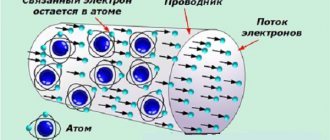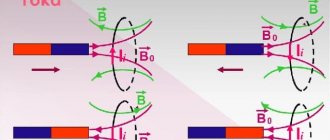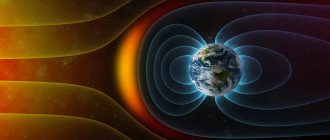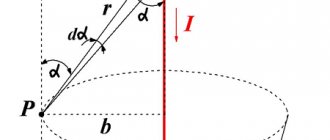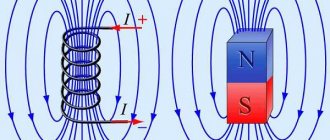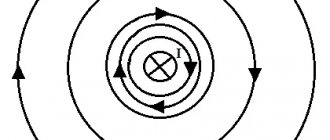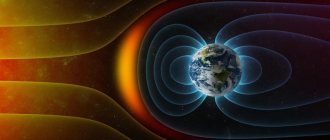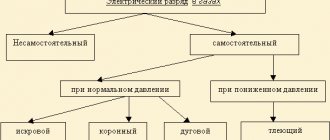4.5
Average rating: 4.5
Total ratings received: 252.
4.5
Average rating: 4.5
Total ratings received: 252.
One of the consequences of Maxwell's equations of electrodynamics is the existence of an electric field that has no sources - charges. Such an electric field is called a vortex field. Let's talk briefly about the vortex electric field.
Electromagnetic induction
According to the law of electromagnetic induction, when the magnetic flux changes through a closed loop, an induced emf is induced in it. Its formula:
$$\mathscr{E}= -{Δ\Phi \over Δt}$$
What is the mechanism for the occurrence of EMF in the circuit?
The occurrence of EMF means that forces appear in the circuit that move free charge carriers in the circuit material. The magnetic field penetrating the circuit does not interact with carriers: it does not affect charges at rest. Thus, the only forces that can move charges in it are the forces of the electric field.
Consequently, when the magnetic field changes, an electric field appears in the circuit, which moves charges and creates an induced emf.
Rice. 1. Electromagnetic induction.
Ferrites
Radio equipment operates at the highest frequencies, where the number reaches millions of vibrations per second. Core coils will not be effective here, since Foucault currents will appear in each plate.
There are magnet insulators called ferrites. Eddy currents will not appear in them during magnetization reversal. Therefore, energy losses for heat are reduced to a minimum. They are used to make cores used for high-frequency transformers, transistor antennas, and so on. They are obtained from a mixture of initial substances, which is pressed and thermally treated.
If the magnetic field in a ferromagnet changes rapidly, this leads to the appearance of induced currents. Their magnetic field will prevent the magnetic flux in the core from changing. Therefore, the flux will not change, but the core will not be remagnetized. Eddy currents in ferrites are so small that they can quickly remagnetize.
Vortex electric field
However, the field arising in the circuit has an important difference from the electric field generated by charges (static electric field). The lines of force of a static field begin and end on charges, but in this case there are no charges, which means that the lines of the resulting electric field do not have a beginning and an end - they are closed.
A field with closed lines of force is called a vortex field. For example, all existing magnetic fields are vortex. The theory does not prohibit the existence of a static magnetic field, but magnetic charges have not yet been discovered. Exactly the same vortex field is the one that arises in the circuit when the magnetic flux through the circuit changes.
The essence of the mechanism of electromagnetic induction is that a change in the magnetic field generates a vortex electric field, which sets the charges in the circuit in motion, creating an induced emf.
The faster the flow through the circuit changes, the greater the intensity of the electric field generated by it. The direction of the electric field coincides with the direction of the induction current in the circuit, which means it is also determined by Lenz’s rule: the induction current arising in a closed circuit is directed so as to counteract the cause that causes it.
As the magnetic flux through the circuit increases, the direction of the vortex electric field can be determined by the right hand grip rule: if the thumb of the right hand points to the direction of the magnetic field, then the four wrapping fingers will indicate the direction of the vortex electric field. As the magnetic flux decreases, the direction of the vortex field will change to the opposite.
Rice. 2. Vortex electric field.
Electromagnetic field
“...Scientific activity... is the only thing
what survives you and what is hundreds and
thousands of years into the history of mankind.”
A.F. Ioffe
In previous topics it was said that an induced current
when changing the magnetic flux penetrating the surface bounded by the contour.
This phenomenon is called the phenomenon of electromagnetic induction
.
From Faraday's experiments it was established that the average value of the induced emf in a conducting circuit is proportional to the rate of change of the magnetic flux through the surface bounded by the circuit. This statement expresses the law of electromagnetic induction
.
The phenomenon of induced emf is completely subject to the law of conservation of energy
.
There is always a magnetic field around a circuit through which an electric current passes, and the magnetic field arises and disappears along with the appearance and disappearance of the current
.
Thus, according to the law of conservation of energy, the energy of the magnetic field created by the current is equal to the energy that the current source (for example, a galvanic cell or a generator in a power plant) must expend to create the current. When the circuit is opened, this energy transforms into other forms
.
It is natural to assume that the energy of the magnetic field should be equal to the work expended by the current to create this field. Moreover, it is equal to the work against the self-inductive emf forces that occurs when the circuit is closed.
Let's calculate this work. To do this, consider the simplest scheme. L to a current source
.
If now, using a key, we close the circuit, then in some short period of time D t
The current strength will increase from zero to a certain
value
I. Also, the magnetic flux will increase from zero to a certain value LI
.
The instantaneous increase in current in the circuit will be prevented by the phenomenon of self-induction
, arising in the circuit.
From the 8th grade physics course it is known that over a certain period of time a charge equal to the product of the current strength and the period of time will be transferred through the circuit.
In the case under consideration, the formula is written for a uniform increase in current in the circuit
. If the current in the circuit does not increase evenly, then it will be necessary to consider short periods of time, during which the rate of change of current can be considered constant.
When transferring charge, the current source will do work, the value of which can be found as the product of the self-inductive emf, taken with the opposite sign, and the charge passed through the circuit.
Substituting the value of the charge and the value of the self-induction emf into the resulting formula, we obtain the formula for the work:
The value of this work performed by the current source against the self-inductive emf will be equal to the energy of the magnetic field (the second and third parts of the formula are obtained by expressing one of the quantities from the formula for magnetic flux).
The second and third parts of the formula are obtained by expressing one of the quantities from the formula for magnetic flux.
If the magnetic field is created by the current passing in the solenoid
, then the energy of the magnetic field of the solenoid with current can be calculated using the formula:
According to the short-range theory, the magnetic field energy
(similarly to the energy of the electric field)
is distributed throughout the entire volume of space in which the magnetic field exists
.
The value equal to the magnetic field energy contained in a unit volume of this field will be called the volumetric magnetic field energy density.
It can be calculated using the formula:
If we consider a moving conductor in a magnetic field, then the occurrence of induced emf is explained quite simply. The thing is that when a conductor moves in a magnetic field, a redistribution of charges inside the conductor occurs: positive charges accumulate at one end of the conductor, negative charges at the other. And this redistribution of charges will occur until the electric force compensates for the Lorentz force.
If we decompose the Lorentz force vector into two components: those directed along the conductor and perpendicular to it, then it is the longitudinal component that will do the work of separating electric charges
.
If such a conductor is short-circuited, an induced current will pass through the circuit
.
However, if a closed conductor located in a magnetic field is stationary, then the occurrence of induced emf cannot be explained by the action of the Lorentz force, since it acts only on moving electric charges.
However, from the 10th grade physics course it is known that the movement of charges can also occur under the influence of an electric field. This means that we can assume that electrons in a stationary conductor are set in motion by an electric field, and this field is directly generated by an alternating magnetic field.
James Clerk Maxwell first came to this conclusion.
The electric field created by an alternating magnetic field was called the induced electric field
.
It is created at any point in space where there is an alternating magnetic field, regardless of whether there is a conducting circuit there or not. The circuit only allows one to detect the emerging electric field. Thus, Maxwell generalized Faraday's ideas about the phenomenon of electromagnetic induction, showing that it is in the occurrence of an induced electric field caused by a change in the magnetic field that the physical meaning of the phenomenon of electromagnetic induction lies.
The induced electric field differs from the known electrostatic and stationary electric fields. Firstly, it is caused not by some charge distribution, but by an alternating magnetic field. Secondly, unlike electrostatic and stationary electric field lines, which begin on positive charges and end on negative charges, induced field lines are closed lines.
Therefore this field is
a vortex field.
As various studies have shown , the magnetic field induction lines and the vortex electric field strength lines are located in mutually perpendicular planes
.
The vortex electric field is related to the alternating magnetic field inducing it by the rule of the left screw:
if the tip of the left screw moves progressively in the direction of change in the magnetic induction vector, then the rotation of the screw head will indicate the direction of the lines of intensity of the induced electric field.
Thirdly, the induced electric field is not potential.
The potential difference
between any two points of a conductor through which an induced current passes
is zero
.
The work done by this field when moving a charge along a closed path is not zero. That is, in this case, the induced emf is the work of the induced electric field to move a unit charge along the closed circuit under consideration
.
Therefore, it is not the potential, but the induced emf that is the energy characteristic of the induced field
.
In the mid-60s of the 19th century, James Maxwell came to the conclusion that, along with the process of the appearance of a vortex electric field when the magnetic field changes, there must also be an inverse process, consisting in the fact that an alternating electric field causes the appearance of an alternating magnetic field,
the induction lines of which cover the lines of intensity of the alternating electric field and are connected with it by the rule of the right screw.
According to Maxwell's hypothesis, the magnetic field, for example, when charging a capacitor after closing the switch, is created not only by the current in the conductor, but also by the changing electric field existing in the space between the plates of the capacitor. Moreover, the changing electric field creates the same magnetic field as if there was an electric current between the plates, the same as in the conductor.
Thus, Maxwell concluded that the vortex electric and magnetic fields are “linked” to each other, exist simultaneously and mutually generate each other
.
The set of vortex electric and magnetic fields inextricably linked with each other is called an electromagnetic field.
It is noteworthy that Maxwell predicted the existence of the electromagnetic field 22 years before it was discovered experimentally.
After the discovery of the relationship between changing electric and magnetic fields, it became clear that these fields do not exist separately, independently of one another. Those. It is impossible to create an alternating magnetic field without simultaneously creating an electric field in space. Conversely, an alternating electric field cannot exist without a magnetic field.
A separate consideration of the electric and magnetic fields has only a relative meaning
. Thus, if an electrostatic field is created by a system of stationary charges, then these charges, being stationary relative to one inertial frame of reference, can move relative to another and, therefore, will generate not only an electric, but also a magnetic field. Similarly, in the reference frame associated with a magnet, only a magnetic field is detected. But an observer moving relative to the magnet will also detect an electric field. Indeed, in a reference frame moving relative to the magnet, the magnetic field will change over time as the observer approaches the magnet or moves away from it. And, as we have already found out, a time-varying magnetic field generates a vortex electric field.
Thus, we can conclude that in nature there is a single electromagnetic field,
those.
a special type of matter through which electromagnetic interactions occur in nature
.
Exercises.
Task:
If it were possible to create large superconducting coils without an external current source, with an inductance of, for example, 100 H, then how much ice, taken at the melting point, can be turned into water and heated to 100 ° C due to the energy of the magnetic field of this coil, if the force the current in it is 10 kA?
Main conclusions:
– A magnetic field
, like an electric one,
has energy
directly proportional to the square of the current.
– Maxwell's hypothesis:
an alternating electric field generates an alternating magnetic field. And, conversely, in any region of space where an alternating magnetic field exists, a vortex electric field appears.
– Electromagnetic field
- this is a special type of matter through which electromagnetic interactions are carried out in nature.
Displacement current and electromagnetic wave
Since the eddy magnetic field is generated by a current flowing through a conductor, J. Maxwell, when developing the theory of electromagnetism, suggested that the eddy electric field is also generated by a similar process, which was called displacement current (as opposed to the usual conduction current). Just as conduction current is the "motion" of an electric field, displacement current can be thought of as the "motion" of a magnetic field. It is the displacement current that generates the vortex electric field. And the electric field, in turn creating an ordinary electric current, generates a vortex magnetic field.
As a result, when the electric and magnetic fields change in space, a propagating structure of mutually generating magnetic and electric fields, called an electromagnetic wave, immediately forms.
Rice. 3. Electromagnetic wave.
Inductance
Passing along the circuit, the electric current contributes to the formation of a set of magnetic lines of force around it. According to the formula Ф = L×I, the flux Ф created by the magnet depends proportionally on the current strength I.
Thus, inductance L is understood as the coefficient of the ratio between the magnetic flux Ф and the current I flowing through the circuit. This value is calculated using the following formula:
L=F/I.
The unit of measurement for this physical quantity is Henry (H). 1 H is the inductance formed in a closed circuit in which the current changes by 1 Ampere, and the voltage in it is 1 Volt.
